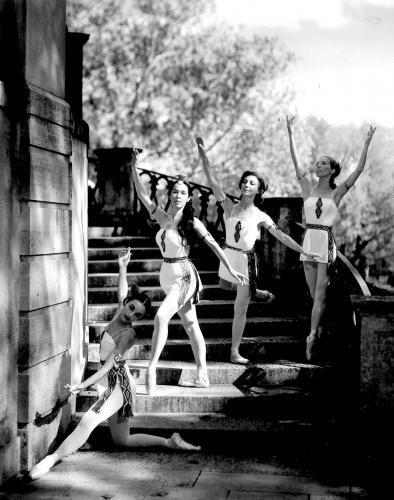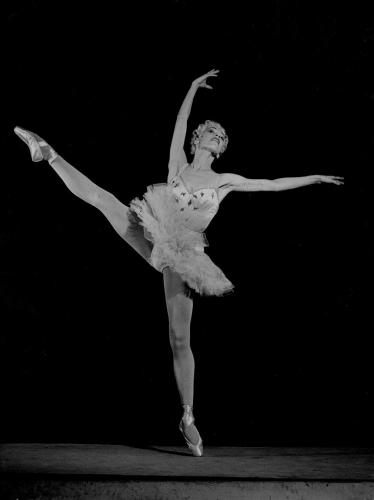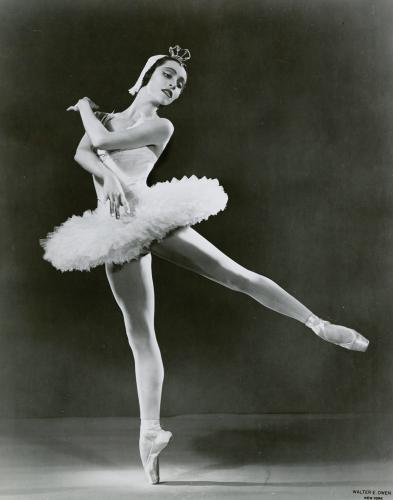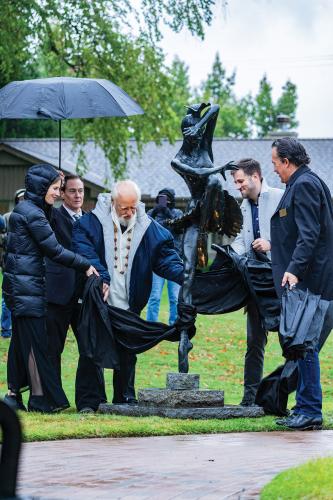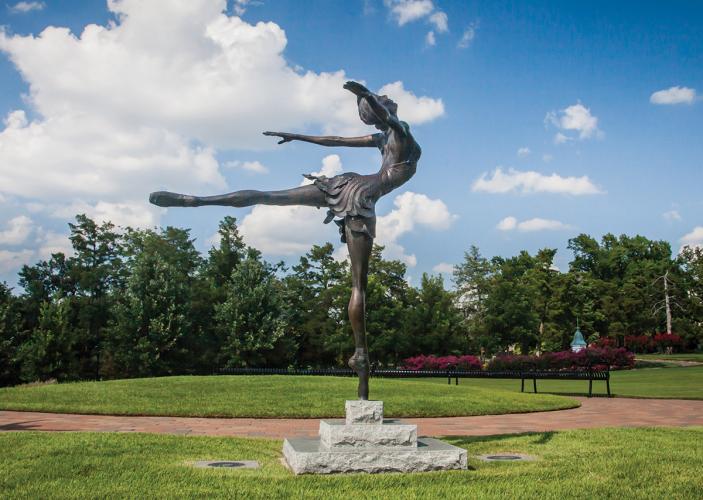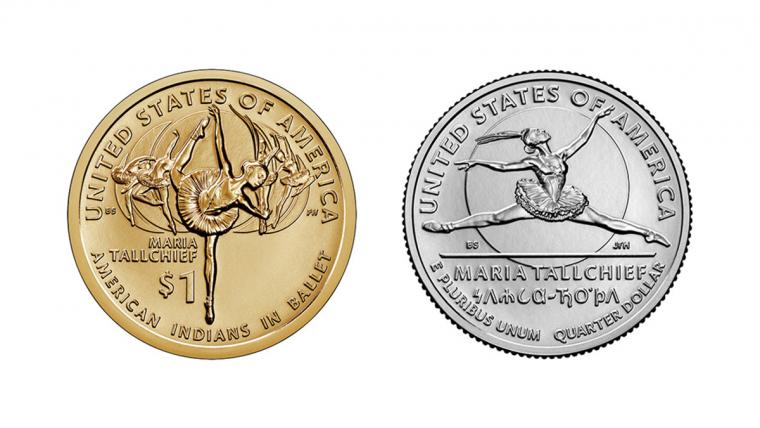October 29, 2023, was a cold and rainy day outside the Tulsa Historical Society and Museum, but it was also a time of heartwarming celebration. More than 500 people gathered to honor ballerinas Maria and Marjorie Tallchief, two Osage sisters who even eight decades after first dancing on the stage are still captivating audiences.
The United States Mint had just released the 10th of its American Women Quarters series featuring the world-renowned prima ballerina Maria Tallchief leaping across the face of the coin. Her Osage name, Wa-Xthe-Thonba (Two Standards, in reference to her dancing to traditional Native songs while also as a ballerina) is etched in Osage orthography below her image.
Earlier in the year, her image, that of her sister and three other Indigenous ballerinas from Oklahoma—Yvonne Chouteau (Shawnee/Cherokee), Moscelyne Larkin (Eastern Shawnee/Peoria) and Rosella Hightower (Choctaw)—appeared on a new U.S. dollar as part of the Native American $1 Coin Program. Collectively the dancers became known as the Five Moons following a 1967 ballet titled “The Four Moons” at which four of the ballerinas performed (Maria Tallchief was unable to attend).
“These five Indigenous women led the path to show Native American youth that anything is possible,” said Cray Bauxmont-Flynn (Cherokee/Delaware), the Tulsa Historical Society and Museum’s interim executive director.
The five were also immortalized at a dedication in 2007 by sculptor Gary Henson (Cherokee/Shawnee). His fellow sculptor Monte England had passed away early in the process of creating the bronze sculptures of the women that then formed a circle outside the museum. But then in 2022, Marjorie Tallchief’s statue was sawed off its base, broken apart and sold for scrap metal. Henson vowed to recreate the sculpture. Henson, who had been sculpting in bronze since he was 16 years old, spent a year restoring Marjorie Tallchief’s statue, casting a missing arm and leg, filling holes, heating and hammering out dents from the inside, welding, grinding and sanding. “I thought it was important to restore it as a statement,” he said. “It was so extreme. Anytime anything awful happens, we should restore it.”
The broken circle of dancers was healed at the October celebration when the restored sculpture was unveiled on the grounds of the museum along with the new coin. Hosted by the Osage Nation, the United States Mint, the Smithsonian American Women’s History Museum and the Tulsa Historical Society, the event brought together members of the Tallchief family, dancers and dignitaries. Nathalie Skibine (Osage), Marjorie Tallchief’s granddaughter, said “I hadn’t seen my grandmother since before COVID, and then she died in 2021. It was sad, but the silver lining was the rededication [of her sculpture] and celebration of the quarter.”
Among the speakers at the event was U.S. Treasurer and Chief of the Mohegan Tribe Marilynn Malerba, who told the crowd, “The women’s quarter program is fairly select, so the fact that Maria Tallchief is on a quarter is extremely special to every Native child, male or female. We are celebrating someone who has made a worldwide impact, but at the heart of it, she’s an Osage Nation citizen.”
Also attending was Jennifer Schneider, program manager of the American Women’s History Initiative at the Smithsonian American Women’s History Museum, which consults with the Mint on selecting the women depicted on the quarters. The vetting process, she explained, included 11,000 public submissions plus consultations with others, including a curator and two historians from the National Museum of the American Indian, who recommended Maria Tallchief for the series.
“The American Women Quarters program is significant to amplify and promote a better understanding of the important contributions of Native American women in the arts, history and sciences,” said Michelle Delaney, NMAI assistant director for History and Culture. “It was an honor to help nominate Maria Tallchief and participate in the selection of the final design of her coin.”
Reflecting on the October celebration, Schneider added that, “It was clear to me how beloved she [Maria] is by the Osage Nation and by members of the general public.” At the event, Malerba, Maria’s daughter Elise Paschen, Osage artist Dana Bear, NMAI’s Head of Collections Care and Stewardship Cali Martin (Osage/Kaw) and former principal dancer for American Ballet Theatre Misty Copeland each poured a bag of Tallchief quarters into a cedar box lined with an Osage woman’s woven belt and containing a pair of ballet shoes beaded for Copeland.
G.T. Bynum, the mayor of Tulsa, a city adjacent to the Osage, Cherokee and Muscogee (Creek) Nations, also issued a proclamation declaring it “Maria and Marjorie Tallchief Day.” In 1953, the state of Oklahoma had created a Maria Tallchief Day at the same time the Osage Tribal Council had given Maria her Osage name, Two Standards, chosen by her grandmother Eliza Bigheart Tall Chief to reflect Maria’s life in two worlds.
Maria and Marjorie Tallchief were born in the Osage town of Fairfax in 1925 and 1926, respectively, at a time when dozens of Osage women and men were being murdered for their “headrights,” or the right to sell proceeds from their oil-rich land. Through their artistic skill and discipline, these Osage sisters would become famous in the 20th century not as victims of colonial violence but as leading forces in the world of ballet and global culture, amplified by the performances of their fellow dancers Chouteau, Larkin and Hightower.
Their mother moved the girls to Los Angeles in 1933 to get them the best available dance instruction. After graduating from high school, Maria moved to New York at age 17. As ballet was still dominated by Russian performers, she was encouraged to change her Osage name to the more Slavic-sounding “Tallchieva,” which she refused to do. Instead, she decided to change her last name of Tall Chief to Tallchief.
Maria Tallchief, in collaboration with famed choreographer George Balanchine (to whom she was married for six years), gained world recognition with her 1949 performance of “Firebird,” which put Balanchine’s newly formed New York City Ballet on the map. She became America’s first prima ballerina, and her other performances, including in “Swan Lake” and as the original Sugar Plum Fairy in “The Nutcracker,” secured Maria’s enduring fame. By 1960, she was invited to become the first American dancer to perform at Moscow’s Bolshoi Theatre. She also performed for U.S. President John F. Kennedy in 1962, and in 1996 was a Kennedy Center Honors recipient, just one of the many awards she would accumulate during her lifetime.
Her sister, Marjorie Tallchief, became a “danseuse étoile,” or “star dancer,” for the prestigious Paris Opera Ballet in 1957, the first American and Native American to achieve that distinction. She performed in many ballets, including “Idylle,” from which her statue’s pose (en point, opposite knee raised, arms in flight) is taken.
Marjorie also helped her sister establish the Chicago City Ballet after Maria remarried and moved to Chicago, where she had a daughter she named Elise. “I grew up a backstage baby,” recalled Elise Paschen (Osage), who is now a poet and writing professor at the Art Institute of Chicago. “I often traveled with my mother and got to see her on stage. I watched her perform in ‘Cinderella,’ and there’s a photo of mom and me when I was 2-years-old after ‘Swan Lake.’ I saw her transform into these magic creatures and the incredible work behind her artistry. … We’d also go to Oklahoma every summer to see my grandmother in Fairfax. So I had both inspirations—the artistic and the Osage cultural background—growing up.”
One of Paschen’s poems, “Wi’-gi-e,” is about the 1920s Reign of Terror directed against the Osage in Oklahoma to steal their oil wealth and includes a reference to the “Killer of the Flowers Moon.” This inspired the title of author David Grann’s best-selling investigative book “Killers of the Flower Moon” on which the Martin Scorsese movie is based. Actress Lily Gladstone (Blackfeet/Nez Perce), who stars in the film, spoke at the October celebration. She read a letter she had written when she was a 9-year-old girl on the Blackfeet Indian Reservation in Montana to her idol Maria Tallchief. It reads in part, “I hope one day I will grow up to be like you because I want to be a famous ballerina, too. ... Sincerely, your biggest fan, Lily Gladstone.”
Also at the event, several youthful dancers from the Dance Maker Performing Arts Academy in Pawhuska, the capitol of the Osage Nation, performed scenes from “The Nutcracker” and “Swan Lake.” The academy is 28 miles from Fairfax, where the Tallchief girls spent their childhood. With a town population of just 3,500, the school averages 80 to 90 female and male students per year, 80 percent of whom are typically Indigenous youth and many of whom are from the Osage Nation. On the academy website is a quote from Maria Tallchief, “From your first plié you are learning to become an artist. In every sense of the word, you are poetry in motion.”
“A lot of Osage [people] who are over 60-years-old [today] all took ballet. The men, after football practice, they’d go to study ballet. I’ve never had an Osage ask me, ‘Why ballet?’ because it’s become part of our culture, thanks to Maria,” explained Randy Tinker Smith (Osage), who founded the academy along with her daughter Jenna Smith LaViolette (Osage) in 2014. She produced and her daughter choreographed the Osage ballet, “Wahzhazhe,” which was performed at the NMAI in 2013.
“I can’t tell you how it’s helped these kids,” said Tinker Smith. “The first year they didn’t know what a dress rehearsal was. Now when they go onstage and all the parents and grandparents see their kids accomplishing something, doing better than they did. There’s just a lot of pride.”
Maria died in 2013, and Marjorie followed in 2021, the last of the Five Moons to pass. Yet these star ballerinas are still making a contribution to their Osage community. Tinker Smith said, “We are their legacy.”

